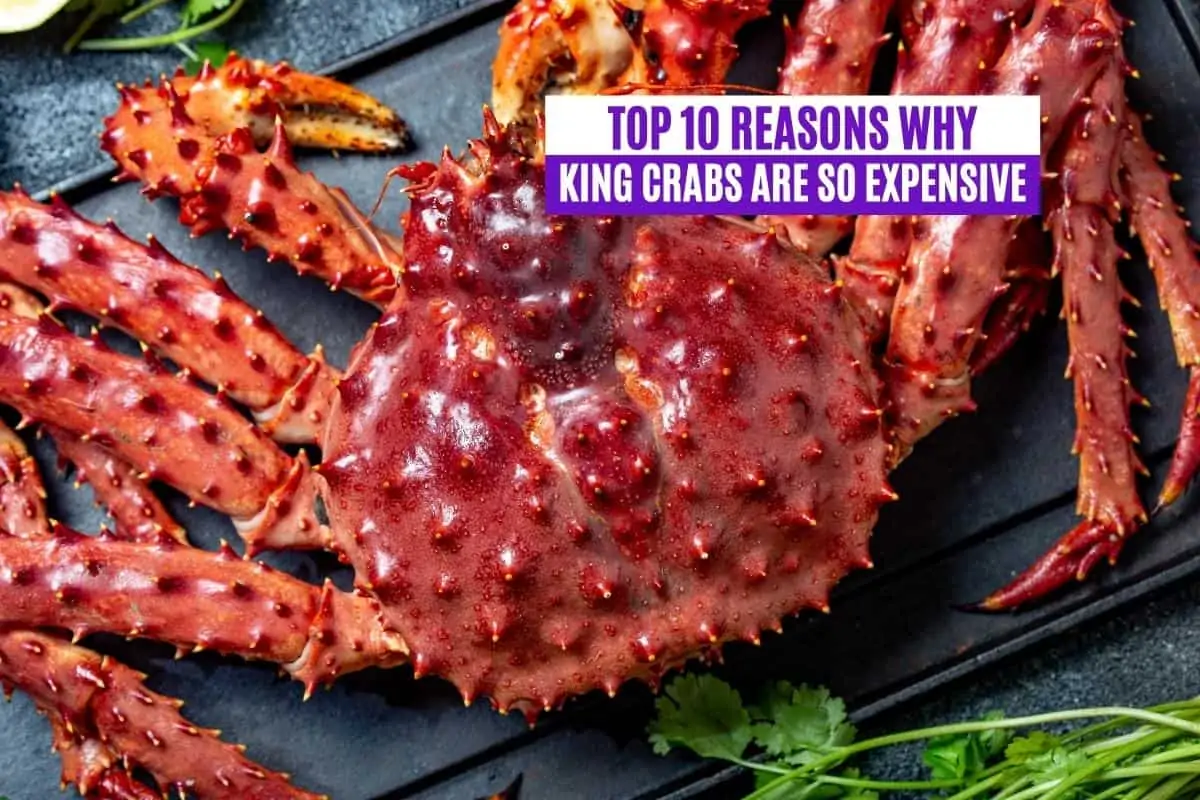You can find mouthwateringly delicious king crab at almost every top-rated seafood restaurant. Still, dishes containing king crab tend to cost $50 or more! But Alaskan king crabs populations are thriving, so why are king crabs so expensive?
Harvesting king crabs is dangerous, which is the primary reason why they’re expensive. Anglers who fish for king crabs tend to earn higher-than-average annual salaries due to the hazards of fishing for king crabs. Also, king crabs live in remote, cold waters. Reaching these areas can be costly.
Let’s explore the many reasons king crabs are more expensive than other types of seafood. When you’re familiar with the costs that influence a king crab’s price, you might have a new appreciation for the effort it takes to get this crab from the ocean to your plate.
Here Are the Top 10 Reasons Why King Crabs Are So Expensive:
- Harvesting king crabs is dangerous
- Some harvesting locations are more desirable
- King crabs live in remote environments
- All king crabs are wild
- Fresh king crab is only available during specific seasons
- Transporting fresh king crab is expensive
- King crab tastes like high-quality lobster
- Quotas prevent overfishing and limit supply
- People prefer large king crab legs
- There are several king crab dishes
10. There Are Several King Crab Dishes
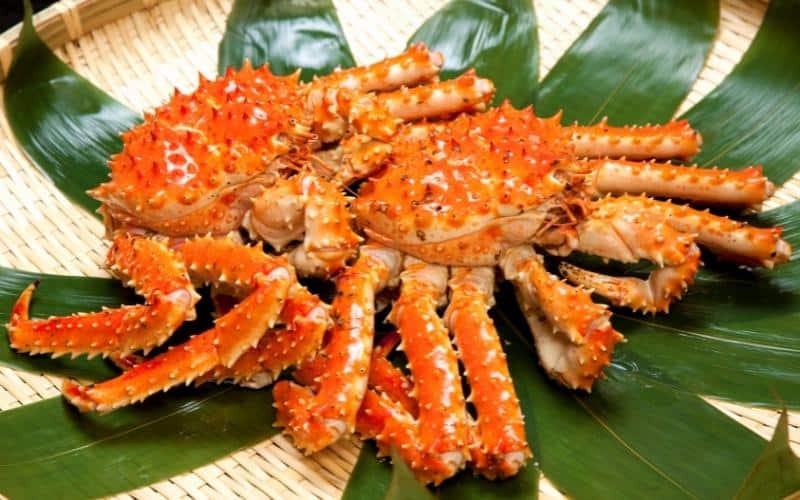
Unlike some types of expensive seafood, like high-cost sea urchins, king crab is used in various dishes.
Steamed king crab legs are a popular way to enjoy king crab. But king crab leg meat is also used to make crab cakes, crab rolls, and savory seafood soups.
Because king crab is used to create many tasty dishes, there’s a higher demand for king crab meat, raising prices. It’s also worth noting that king crab legs come in different sizes. And the bigger the portion, the higher the price.
9. People Prefer Large King Crab Legs
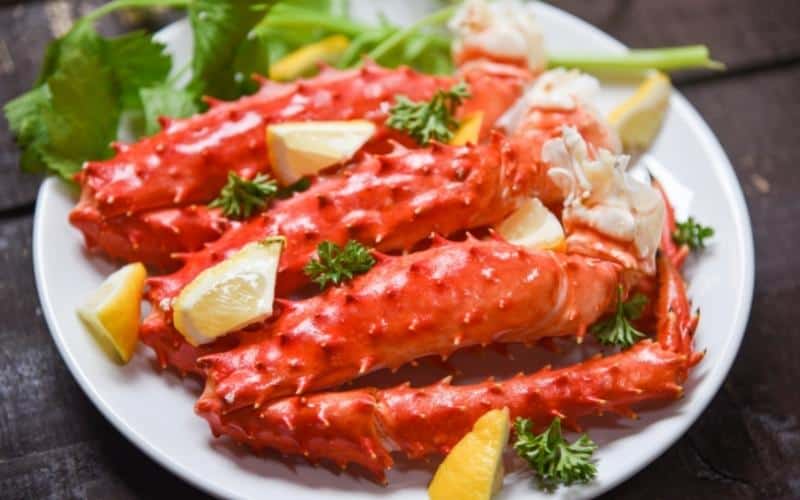
Generally, king crab legs fall into one of several size categories:
- Jumbo
- Giant
- Colossal
- Super Colossal
The largest size, Super Colossal, is the most expensive. That’s because larger crab legs contain more meat!
So, while a pound of Jumbo king crab legs might cost about $20, a pound of Super Colossal legs typically retails for $100. Seafood lovers who enjoy steamed crab legs tend to gravitate toward the larger sizes, increasing the demand (and the price) for these heftier portions.
While king crabs aren’t endangered, the supply of fresh king crab is extremely limited. After all, many countries adhere to strict fishing quotas to prevent overfishing.
8. Quotas Prevent Overfishing and Limit Supply
The three countries with the highest king crab output are the United States, Norway, and Canada. These countries have strict harvesting quotas to prevent anglers from overfishing, keeping king crab population numbers high.
While this practice is an excellent way to ensure that wild king crab populations continue to thrive, it also means that demand for king crab always outpaces supply, resulting in higher prices.
Additionally, anglers cannot harvest king crabs below a specific weight limit. For example, legally harvested king crabs must weigh more than seven pounds. This rule keeps juvenile king crabs in the water, encouraging further population growth over time.
But diners love the savory taste of king crab legs. Their taste is often compared to the flavor of a high-quality lobster, making them a popular choice among seafood lovers around the world. This desirable flavor profile is another reason why king crabs are so expensive.
7. King Crab Tastes Like High-Quality Lobster
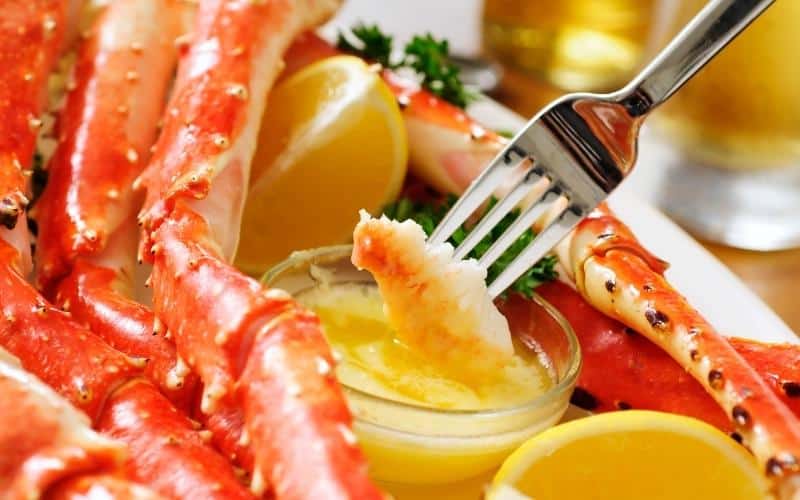
Many of the world’s most expensive foods have outrageously high price tags because they’re delicious! King crab is no exception, with a complex flavor profile that can please even the most particular palates.
King crab legs are slightly sweet, so they feature a balance of natural saltiness and unique sugariness. They’re also full of tender, melt-in-your-mouth meat. As a result, these crab legs are often compared to the highest-quality lobster meats.
But while lobster populations suffer from overfishing, leading to severe shortages, king crabs are protected by several fishing regulations and laws. This difference in fishing practices has altered public opinion, leading to a higher demand for king crab and lower demand for lobster.
As the law of supply and demand dictates, any high-demand good will enjoy a price boost. But the increased call for king crab is just one of the many reasons this seafood is so pricey. Transportation issues also affect prices.
6. Transporting Fresh King Crab Is Expensive
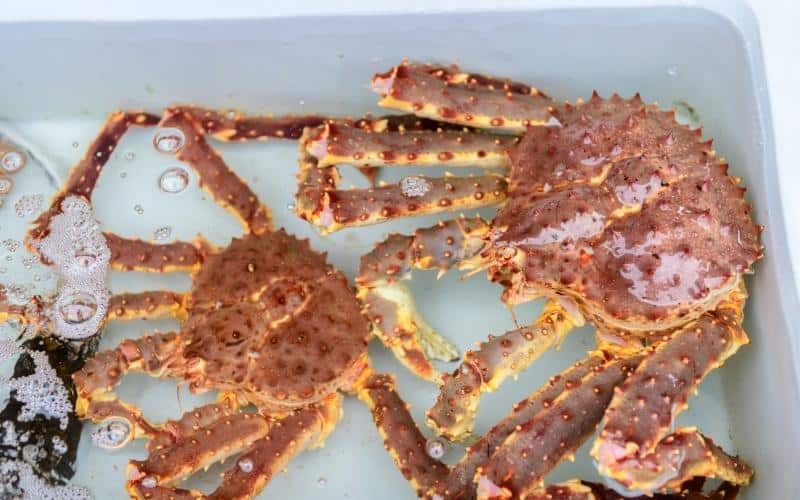
The finest seafood restaurants only order live crustaceans and fresh fish. By avoiding frozen ingredients, world-class chefs can ensure that every meal that leaves their kitchen is of the best possible quality. But this need for fresh ingredients comes at a high cost.
Transporting live seafood can be exceptionally challenging. Not only do countries have strict rules about shipping and handling live animals, especially those from other regions of the world, but keeping aquatic creatures alive and healthy as they travel across the globe can be tricky.
A king crab needs a cold saltwater tank to survive. They also have high-maintenance diets, as adults are primarily carnivorous. Consequently, in-transit live king crabs need a regular diet of fish, clams, snails, or small crabs.
Keeping a king crab’s tank cold and clean during transit requires plenty of planning, a refrigeration unit, and extra care. These requirements significantly increase the price of a live king crab, especially during the off-peak seasons.
King crabs are only harvested during the fall and early winter months, and keeping them alive for an extended period during spring and summer can quickly add hundreds of dollars to a live crab’s price tag.
5. Fresh King Crab Is Only Available During Specific Seasons
Frozen king crab legs are slightly more affordable than fresh ones, but not by much. That’s because the annual haul of king crab is limited.
Anglers can only harvest these crustaceans during the fall and early winter. Whatever they catch during this time must last for the remainder of the off-peak season. This limited availability significantly affects the price of a king crab.
The best time of the year to invest in king crab legs is during the late winter and early spring season. In January and February, the harvest of king crabs is at its highest level and is incredibly fresh.
After this point, the supply begins to run low. As a result, prices tend to hit their highest point during the summer and fall, often increasing by 60%.
But, you may be wondering, “Why don’t aquaculturists build farms to keep the king crab supply constant throughout the year?” After all, there are plenty of seafood farms around the world, many of which produce fish, shellfish, and crustaceans all year long.
4. All King Crabs Are Wild
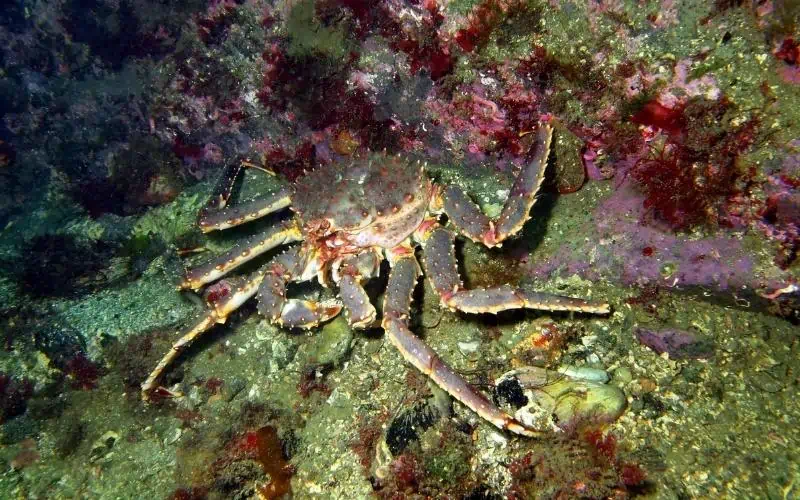
Unfortunately, you can’t farm king crabs. These creatures live in deep ocean environments and can take decades to reach a harvestable size. They also require plenty of space to roam around and reproduce.
Consequently, all king crabs that make it to the dinner table come from wild populations. As you might suspect, wild-caught seafood is almost always pricier than farmed versions.
King crabs will remain a wild-caught delicacy until fish farming techniques and technology improve. And because these crabs live in remote, freezing waters deep beneath the ocean’s surface, harvesting them is a constant challenge.
3. King Crabs Live in Remote Environments
Like some of the world’s most expensive mushrooms, king crabs live in remote environments that can be challenging to access. Anglers harvest Alaskan king crabs from the Gulf of Alaska, Bristol Bay, and Norton Sound. Ice floes are common in these areas, and they can destroy fishing vessels.
Fishing locations are often hundreds of miles away from the nearest coastline or shipyard. As a result, anglers working on fishing vessels may work 20-hour days and spend weeks or months harvesting crabs, with virtually no days off.
Additionally, Alaskan king crabs often live about 600 feet beneath the ocean’s surface. Reaching these areas requires advanced fishing equipment. If this equipment breaks while anglers are out on the water, crews might be unable to harvest any crabs for the season, raising the overall price for king crabs.
But traveling back to shore for a quick repair is out of the question. The time and energy it would take to sail into harvesting locations, return to land, and sail back out again would negatively impact a vessel’s haul.
Thanks to the restricted time limit allocated for harvesting these crabs, anglers are stuck in the remote environments where king crabs live until the end of the harvest season. The fishing vessels and equipment required to transport a crew to these faraway fishing spots are costly, and this expense is eventually added to the initial cost of a king crab.
While consumers could choose to purchase king crabs from other, less remote locations, the demand for Alaskan king crabs is far higher than the demand for Norwegian king crabs. For better or worse, some harvesting locations are more desirable than others.
2. Some Harvesting Locations Are More Desirable
The Gulf of Alaska may be the oldest known king crab habitat. While these crabs have proliferated in the Murmansk Fjord in Norway, they’ve only lived there since the 1960s. On the other hand, Alaskan king crabs have been thriving off the coast of Alaska for hundreds, potentially thousands of years.
They’re also the only domestic source of king crab in the United States. For these reasons, many diners prefer Alaskan king crabs over Norwegian king crabs. Besides, North American restaurants can spend slightly less on king crabs harvested from the ocean surrounding Alaska, which is a significant benefit.
However, because Alaskan king crabs are preferable, there’s a higher demand for them. And, as we’ve mentioned before, higher demand almost always means higher prices.
Still, fishing for Alaskan king crabs isn’t a walk in the park. Many people have died trying to harvest these delicious crustaceans. The inherent danger of harvesting king crabs might be the primary reason these crabs are so expensive.
1. Harvesting King Crabs Is Dangerous
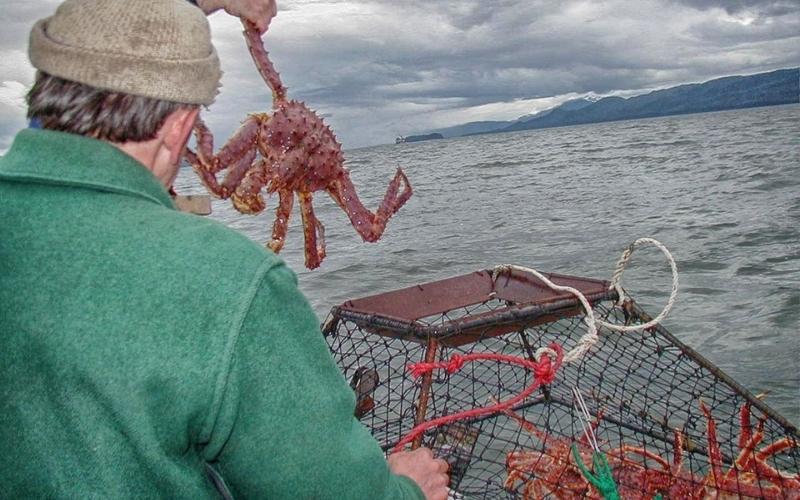
Though supply and demand are some of the most significant factors influencing king crab prices, harvesting challenges might be even more influential. In particular, anglers who harvest king crabs tend to face life-threatening hazards.
Remember, Alaskan king crabs, one of the most popular types of king crabs, live in freezing waters off the coast of remote areas. As a result, anglers who sail into these areas to harvest king crabs can suffer from hypothermia after prolonged exposure to icy winds and low temperatures.
Storms and strong winds can also make this job dangerous. For example, when ice-cold waves pound the decks of a fishing vessel, the anglers aboard the ship are often drenched to the bone.
If they cannot dry off and get warm quickly, their heart rate can slow to a dangerous level, potentially resulting in death.
These turbulent waves can also wash anglers overboard into deep, unforgiving waters. When visibility is poor, it’s almost impossible for crew members to rescue anglers. Sadly, drowning risks are quite high for those who decide to fish for king crabs.
But low temperatures and rough waves aren’t the only dangers anglers face when harvesting king crabs. Heavy equipment, falling ice, and capsized fishing vessels are also potentially fatal risks that anglers encounter.
Fortunately, these brave anglers are compensated for the dangers they face. The average annual salary of someone who fishes for Alaskan king crabs is more than $314,000. But this higher-than-average salary also means that consumers tend to pay higher prices for Alaskan king crabs.
How Much Do King Crabs Cost?
The price for a pound of king crab legs varies depending on harvesting location, leg size, and season. That said, the average cost for a pound of king crab legs ranges between $60 and $75.
Whole king crabs are far more expensive. A live Alaskan king crab can cost $675 for those living in the continental United States.
But they can cost $1,000 or more when transported to international destinations, making them one of the most expensive types of seafood.
Why Are King Crabs So Expensive?
So, why are king crabs so expensive? First, catching these hefty crustaceans is incredibly dangerous. King crab anglers often put their lives on the line to harvest them.
Of course, king crab anglers also enjoy exceptional salaries to compensate for the job hazards. Anglers who harvest Alaskan king crabs earn an average salary of about $314,000. Consumers help pay this salary each time they purchase expensive king crab legs.
Are you interested in learning more about the world’s most expensive foods? If so, check out these related articles now!

